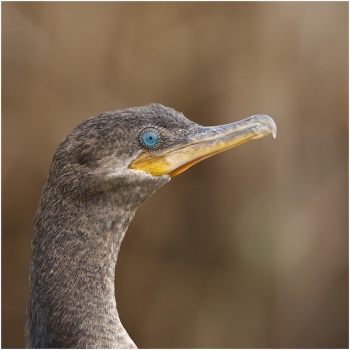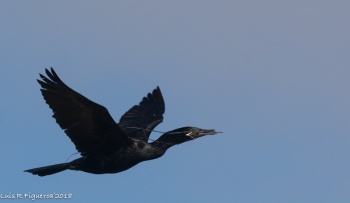m |
m (→External Links) |
||
| (30 intermediate revisions by 12 users not shown) | |||
| Line 1: | Line 1: | ||
| − | + | [[Image:Neotropic_or_Olivaceous_Cormorant.jpg|thumb|400px|right|Subspecies ''brasilianum''<br />Photo © by {{user|Aracari|Aracari}} <br />Sao Paulo Botanical Gardens, [[Brazil]], October 2006]] | |
| − | [[Image:Neotropic_or_Olivaceous_Cormorant.jpg|thumb| | + | '''Alternative names: Neotropical Cormorant; Olivaceous Cormorant''' |
| + | |||
| + | ;[[:Category:Nannopterum|Nannopterum]] brasilianum | ||
| + | ''Phalacrocorax brasilianus'' | ||
| + | |||
==Identification== | ==Identification== | ||
| − | + | 58–73 cm (22¾-28¾ in)<br/> | |
| + | W. 100 cm<br/> | ||
| + | Weight 1-1.5 kg | ||
| + | *Dark brown to blackish | ||
| + | *Yellow-brown throat patch ([[Dictionary_G-L#G|gular]] pouch) which at the rear ends in a sharp point | ||
| + | *Brownish feathering in the [[Topography#Heads|lores]] and [[Dictionary_P-S#S|supraloral]] area | ||
| + | ====Breeding==== | ||
| + | [[Image:Neotropic Cormorant juvenile Anahuac NWR.jpg|thumb|350px|right|First Year bird; subspecies ''mexicanus'' <br />Photo © by {{user|Stanley+Jones|Stanley Jones}}<br />[[Anahuac National Wildlife Refuge]], Chambers County, [[Texas]], [[USA]], September 2017]] | ||
| + | *White tufts on the sides of the head | ||
| + | *Throat patch develops a white edge | ||
| + | ====Juvenile==== | ||
| + | [[File:Neotropic_Cormorant_Pb-mexicanus_JMOR.jpg|thumb|350px|right|Subspecies ''P. b. mexicanus''<br />Photo © by {{user|jmorlan|Joseph Morlan}}<br /> [[High Island]]--Smith Oaks Sanctuary, [[Bolivar Peninsula]], [[Texas]], [[USA]], 19 April 2021]] | ||
| + | Brownish | ||
| + | ====Similar species==== | ||
| + | Compare especially to [[Double-crested Cormorant]] which differ in being larger and stockier, having shorter tail, rounded gular pouch, and yellow bare skin in the loral and supraloral area. Juvenile Double-crested Cormorant is paler on the breast and sometimes even head and neck when compared to same age Neotropic. | ||
| + | ==Distribution== | ||
| + | [[North America]]: [[Mexico]], [[Arizona]], southern [[Texas]], and locally in [[New Mexico]]. Accidental vagrant to [[California]], [[Colorado]], [[Oklahoma]], [[Kansas]], [[Nebraska]], [[South Dakota]], [[Illinois]], [[Alabama]] and most remarkably [[Ontario]]<sup>[[#References|1]]</sup>. The regular occurrence in Arizona is the result of a recent range expansion. <br /> | ||
| + | In the [[Caribbean]] found in [[Bahamas]], [[Turks and Caicos]], and [[Cuba]]. <br /> | ||
| + | [[Central America]] and [[South America]]: found throughout, including Tiera del Fuego at the southern tip of South America. The name, which hints that this is a tropical species therefore is wrong. | ||
| + | |||
| + | ==Taxonomy== | ||
| + | [[Image:Neotropic cormorant9.jpg|thumb|350px|right|Subspecies ''brasilianum''<br />Photo © by {{user|Luis+R|Luis R}}<br />Mouth of Elqui River, La Serena, [[Chile]], November 2018]] | ||
| + | Some field guides<sup>[[#References|2]]</sup> still use ''Phalacrocorax olivaceus'' for this species. | ||
| + | ====Subspecies==== | ||
| + | Two subspecies are recognized<sup>[[#References|[1]]]</sup>: | ||
| + | *''P. b. mexicanus'': | ||
| + | :*Extreme southern [[US]] to [[Nicaragua]], [[Bahamas]], [[Cuba]] and Isle of Pines | ||
| + | *''P. b. brasilianum'': | ||
| + | :*[[Costa Rica]] south through [[South America]] to Tierra del Fuego | ||
| + | |||
| + | ==Habitat== | ||
| + | Sea shores, lakes, and marshes. It can be found in salt water, brackish water, as well as fresh water habitats. | ||
| + | ==Behaviour== | ||
| + | Dives from the surface, swimming well under water to chase prey. Often perches on logs, pilings, tree limbs, or even wires, sometimes spreading its wings in the sun to dry. Usually flies low over the surface of open water with strong, rapid wing beats. | ||
| + | ====Diet==== | ||
| + | Their diet consists of small fish, tadpoles, frogs, crustaceans and aquatic insects. | ||
| + | ====Breeding==== | ||
| + | Their nest is a platform of sticks with a depression in the centre circled with twigs and grass. The clutch contains up to 5 chalky bluish-white eggs which are incubated by both adults for about 25–30 days. | ||
| + | ==References== | ||
| + | #{{Ref-Clements6thAug19}}#2005 Ontario Bird Records Committee Report (http://www.ofo.ca/obrc/includes/2005OBRCReport.pdf) | ||
| + | #Ridgely & Gwynne: A guide to the birds of Panama ISBN 0691025126 | ||
| + | #[http://www.azfo.org/journal/NECO_2008.html RADAMAKER and CORMAN] STATUS OF NEOTROPIC CORMORANT IN ARIZONA WITH NOTES ON IDENTIFICATION AND AGEING | ||
| + | #elfair II, R. C. and M. L. Morrison (2020). Neotropic Cormorant (Phalacrocorax brasiliana), version 2.0. In Birds of the World (P. G. Rodewald and B. K. Keeney, Editors). Cornell Lab of Ornithology, Ithaca, NY, USA. https://doi.org/10.2173/bow.neocor.02 | ||
| + | |||
| + | #Wikipedia | ||
| + | {{ref}} | ||
==External Links== | ==External Links== | ||
| − | + | {{GSearch|"Nannopterum brasilianum" {{!}} "Phalacrocorax brasilianus" {{!}}"Neotropic Cormorant" {{!}} "Neotropical Cormorant" {{!}} "Olivaceous Cormorant"}} | |
| − | [[Category:Birds]] | + | {{GS-checked}}1 |
| + | <br /> | ||
| + | <br /> | ||
| + | |||
| + | [[Category:Birds]] [[Category:Nannopterum]] | ||
Latest revision as of 20:05, 26 June 2023
Alternative names: Neotropical Cormorant; Olivaceous Cormorant
- Nannopterum brasilianum
Phalacrocorax brasilianus
Identification
58–73 cm (22¾-28¾ in)
W. 100 cm
Weight 1-1.5 kg
- Dark brown to blackish
- Yellow-brown throat patch (gular pouch) which at the rear ends in a sharp point
- Brownish feathering in the lores and supraloral area
Breeding

Photo © by Stanley Jones
Anahuac National Wildlife Refuge, Chambers County, Texas, USA, September 2017
- White tufts on the sides of the head
- Throat patch develops a white edge
Juvenile

Photo © by Joseph Morlan
High Island--Smith Oaks Sanctuary, Bolivar Peninsula, Texas, USA, 19 April 2021
Brownish
Similar species
Compare especially to Double-crested Cormorant which differ in being larger and stockier, having shorter tail, rounded gular pouch, and yellow bare skin in the loral and supraloral area. Juvenile Double-crested Cormorant is paler on the breast and sometimes even head and neck when compared to same age Neotropic.
Distribution
North America: Mexico, Arizona, southern Texas, and locally in New Mexico. Accidental vagrant to California, Colorado, Oklahoma, Kansas, Nebraska, South Dakota, Illinois, Alabama and most remarkably Ontario1. The regular occurrence in Arizona is the result of a recent range expansion.
In the Caribbean found in Bahamas, Turks and Caicos, and Cuba.
Central America and South America: found throughout, including Tiera del Fuego at the southern tip of South America. The name, which hints that this is a tropical species therefore is wrong.
Taxonomy
Some field guides2 still use Phalacrocorax olivaceus for this species.
Subspecies
Two subspecies are recognized[1]:
- P. b. mexicanus:
- P. b. brasilianum:
- Costa Rica south through South America to Tierra del Fuego
Habitat
Sea shores, lakes, and marshes. It can be found in salt water, brackish water, as well as fresh water habitats.
Behaviour
Dives from the surface, swimming well under water to chase prey. Often perches on logs, pilings, tree limbs, or even wires, sometimes spreading its wings in the sun to dry. Usually flies low over the surface of open water with strong, rapid wing beats.
Diet
Their diet consists of small fish, tadpoles, frogs, crustaceans and aquatic insects.
Breeding
Their nest is a platform of sticks with a depression in the centre circled with twigs and grass. The clutch contains up to 5 chalky bluish-white eggs which are incubated by both adults for about 25–30 days.
References
- Clements, J. F., T. S. Schulenberg, M. J. Iliff, S. M. Billerman, T. A. Fredericks, B. L. Sullivan, and C. L. Wood. 2019. The eBird/Clements Checklist of Birds of the World: v2019. Downloaded from http://www.birds.cornell.edu/clementschecklist/download/
- 2005 Ontario Bird Records Committee Report (http://www.ofo.ca/obrc/includes/2005OBRCReport.pdf)
- Ridgely & Gwynne: A guide to the birds of Panama ISBN 0691025126
- RADAMAKER and CORMAN STATUS OF NEOTROPIC CORMORANT IN ARIZONA WITH NOTES ON IDENTIFICATION AND AGEING
- elfair II, R. C. and M. L. Morrison (2020). Neotropic Cormorant (Phalacrocorax brasiliana), version 2.0. In Birds of the World (P. G. Rodewald and B. K. Keeney, Editors). Cornell Lab of Ornithology, Ithaca, NY, USA. https://doi.org/10.2173/bow.neocor.02
- Wikipedia
Recommended Citation
- BirdForum Opus contributors. (2024) Neotropic Cormorant. In: BirdForum, the forum for wild birds and birding. Retrieved 11 May 2024 from https://www.birdforum.net/opus/Neotropic_Cormorant
External Links
GSearch checked for 2020 platform.1





